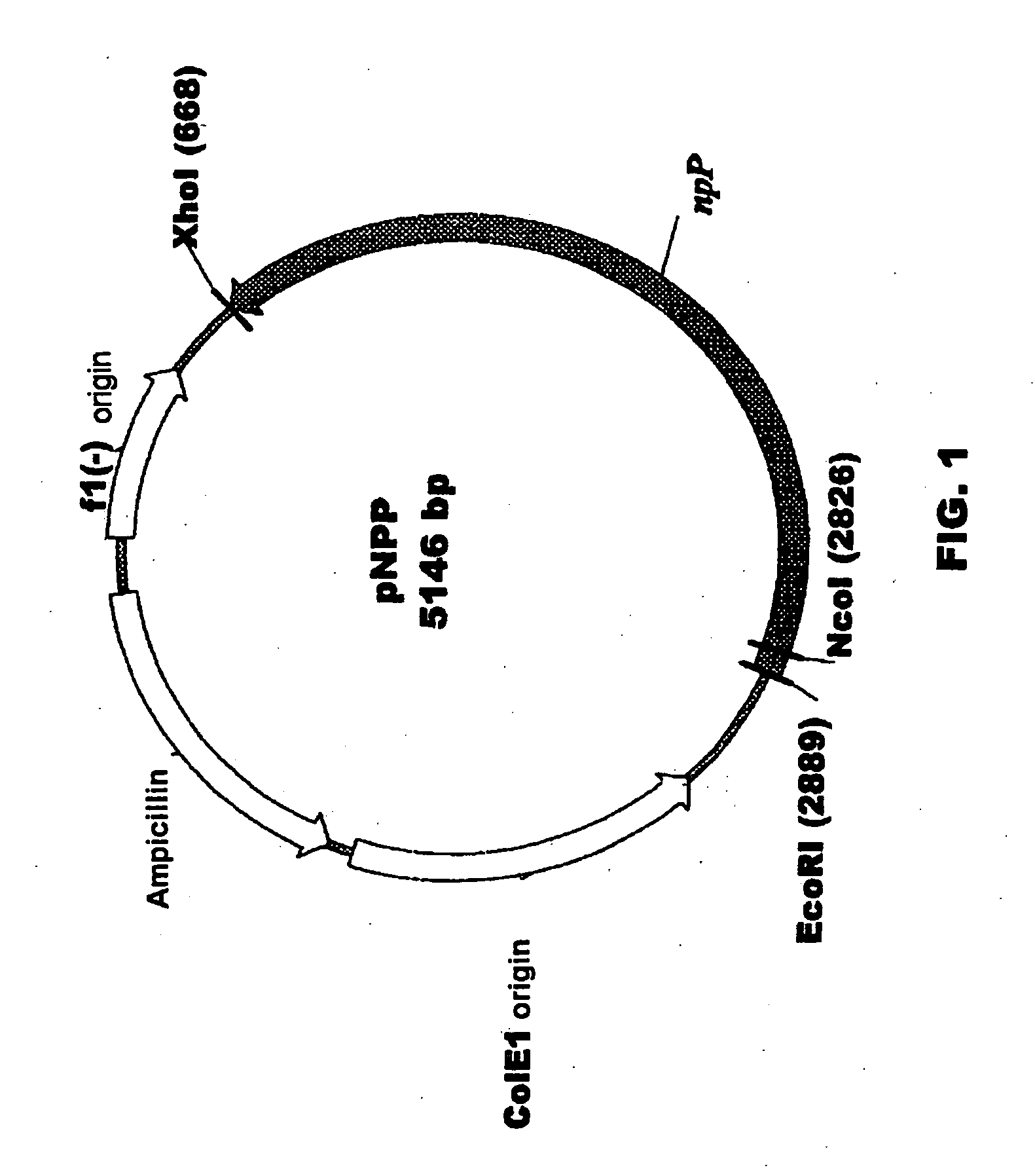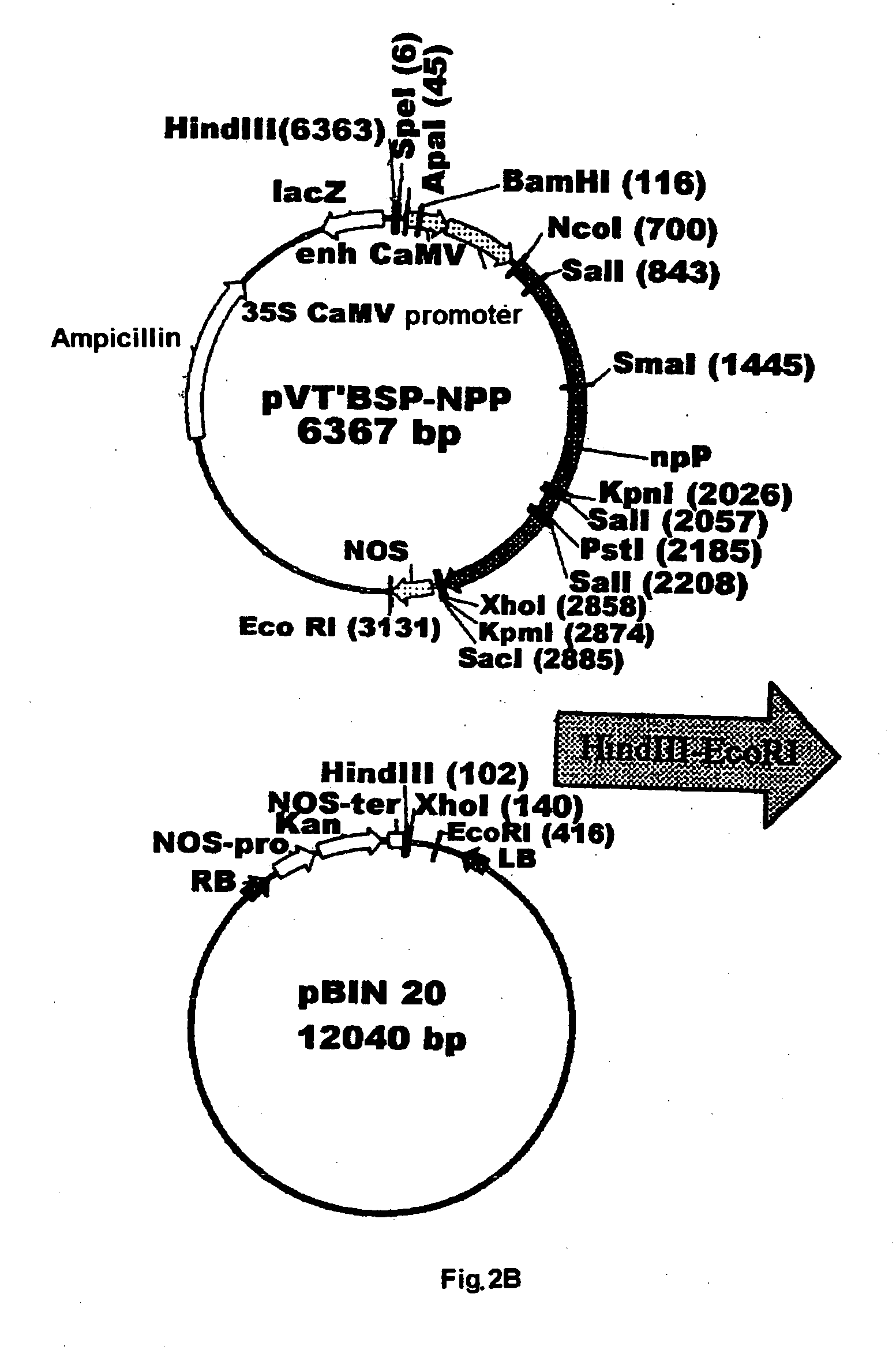Plant nucleotide-sugar pyrophosphatase/phosphodiesterase (nppase), method of obtaining same and use of same in the production of assay devices and in the production of transgenic plants
a technology of phosphodiesterase and plant nucleotide sugar, which is applied in the field of plant nucleotide sugar pyrophosphatase/phosphodiesterase, can solve the problems of requiring a considerable investment in equipment and in the preparation of test samples, and little study of the mechanisms responsible for the degradation of these nucleotide sugars
- Summary
- Abstract
- Description
- Claims
- Application Information
AI Technical Summary
Benefits of technology
Problems solved by technology
Method used
Image
Examples
example 1
Extraction and Purification of the Soluble NPPase Obtained from Barley Leaves
[0056] All the steps were carried out at 4° C., unless indicated otherwise. The plant tissue (900 g) was homogenized with 2900 mL of extraction buffer (Mes 50 mM pH 6, EDTA 1 mM, DTT 2 mM) using a Waring blender. The homogenate was filtered through four layers of Miracloth, centrifuged at 100 000 g for 30 minutes and the supernatant was adjusted to 50% of ammonium sulphate. The precipitate obtained after 30 minutes of centrifugation at 30 000 g (20° C.) was resuspended in 2900 mL of Mes 50 mM pH 4.2, then heated on a water bath at 62° C. for 20 minutes, cooled in ice, and centrifuged at 30 000 g for 20 minutes. The proteins of the supernatant were precipitated using 50% ammonium sulphate, and resuspended in 5.7 mL of Mes 50 mM pH 6. Then the sample was submitted to gel filtration in a Superdex 200 column (Pharmacia LKB Biotechnology, Uppsala, Sweden) pre-equilibrated with Mes pH 6 and NaCl 150 mM. The frac...
example 2
Enzymatic Tests
[0057] Unless stated otherwise, all the enzymatic reactions took place at 37° C. The determinations of NPPase activities were performed using spectrophotometric determination of G1P in two steps described by Sowokinos (1981) (Sowokinos, 1981, Plant Physiol. 68, 924-929). The reaction mixture contained Hepes 50 mM pH 7, the specified quantity of ADPG and the protein extract in a total volume of 50 microlitres. All the assays were performed relative to an ADPG blank. After 20 minutes of incubation, the reaction was stopped by boiling in a dry bath for 2 minutes. The mixture was centrifuged at 20 000 g for 5 minutes and the supernatant was recovered. In the second step, G1P was determined spectrophotometrically in 300 microlitres of mixture containing Hepes 50 mM−pH 7, EDTA 1 mM, MgCl2 2 mM, KCl 15 mM, NAD+ 0.6 mM, one unit of phosphoglucomutase and one unit of glucose-6-phosphate dehydrogenase from Leuconostoc mesenteroides, and 30 microlitres of the supernatant result...
example 3
Identification of the Product with Enzymatic Activity Obtained
[0060] The product with NPPase activity thus obtained complies with the following characteristics: [0061] It catalyses the hydrolysis of ADPG producing equimolar quantities of G1P and AMP. [0062] In addition to ADPG, the NPPase recognizes other small molecules that possess phosphodiester bonds, such as UDPG, GDP-glucose, bis-PNPP and others of similar structure. It also catalyses the hydrolysis of small molecules with phosphosulphate bonds, such as APS, releasing equimolar quantities of sulphate and AMP (Table 2—Vmax in % in relation to ADPG—and Table 3). [0063] It does not hydrolyse molecules with phosphomonoester bonds such as G1P, G6P, AMP, 3-phosphoglycerate, and other similar molecules. Nor does it hydrolyse cyclic AMP or nucleic acids such as DNA and RNA, which are substrates of other phosphodiesterases described in the literature. [0064] Its ionic requirements are reduced, therefore the NPPase can work in the abse...
PUM
| Property | Measurement | Unit |
|---|---|---|
| molecular weight | aaaaa | aaaaa |
| molecular weight | aaaaa | aaaaa |
| temperature | aaaaa | aaaaa |
Abstract
Description
Claims
Application Information
 Login to View More
Login to View More - R&D
- Intellectual Property
- Life Sciences
- Materials
- Tech Scout
- Unparalleled Data Quality
- Higher Quality Content
- 60% Fewer Hallucinations
Browse by: Latest US Patents, China's latest patents, Technical Efficacy Thesaurus, Application Domain, Technology Topic, Popular Technical Reports.
© 2025 PatSnap. All rights reserved.Legal|Privacy policy|Modern Slavery Act Transparency Statement|Sitemap|About US| Contact US: help@patsnap.com



